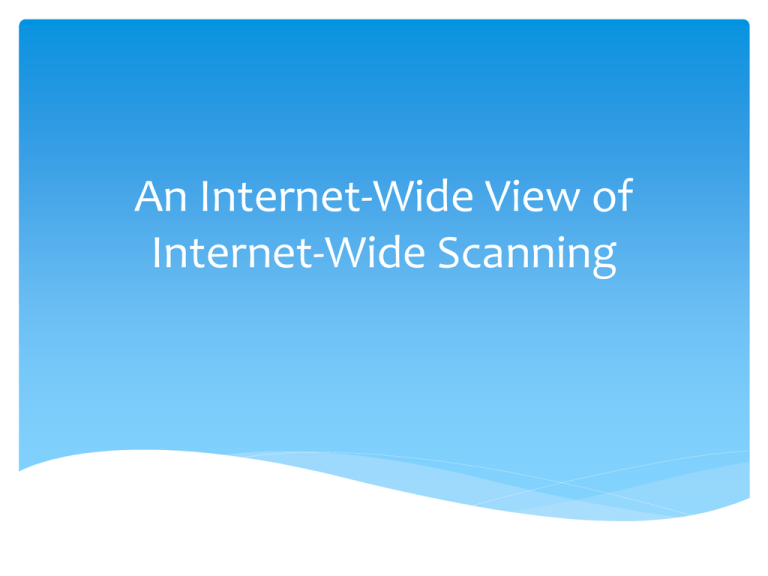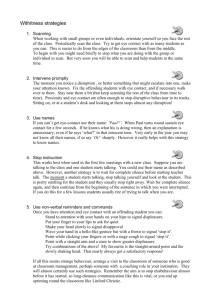Slides
advertisement

An Internet-Wide View of Internet-Wide Scanning What is internet wide scanning? Scanning IPv4 Horizontal scanning – individual ports Network telescope - darknet How is this done? Used to take months! But then ZMap and Masscan What are they? Ipv4 scanners 5 minutes … with 10gbs connections Their impact? Previous work Pang et al, 2004, one of the first comprehensive analyses of Internet background radiation. Covered many aspects of background traffic, including the most frequently scanned protocols However, the scanning landscape has changed drastically in the last decade Previous work Wustrow et al, 2010, studied Internet background radiation Increase in scan traffic destined for SSH (TCP/22) Increased scanning activity targeting port 445 (SMB over IP) in 2009 due to Conficker Telnet (TCP/23) in 2007 Previous work Moore et al. and Cooke et al, The dynamics of performing studies on IPv4 darknet traffic Utilize both studies when performing calculations Take out later Analysed traffic received by a large darknet over a 16month period Excluding Conficker, almost 80% of scan traffic originates from large scans targeting >1% of the IPv4 address space Many scans are being conducted by academic researchers A large portion of all scanning targets services associated with vulnerabilities (e.g. Microsoft RDP, SQL Server) The majority of scanning is completed from bullet-proof hosting providers or from China Dataset A darknet January 1, 2013 to May 1, 2014 5.5 million addresses, 0.145% of the public IPv4 address space Received an average of 1.4 billion packets, or 55 GB of traffic, per day Defined a scan as: a source address contacted at least 100 unique addresses in our darknet on the same port Fingerprinting scanners In ZMap, the IP identification field is statically set to 54321 Masscan : ip_id = dst_addr⊕dst_port⊕tcp_seqnum Scan Dynamics Detected 10.8 million scans from 1.76 million hosts during January 2014 4.5 million (41.7%) are TCP SYN scans targeting less than 1% of the IPv4 address space on port 445 56.4% TCP SYN packets, 35.0% UDP packets, and 8.6% ICMP echo request packets Only 17,918 scans (0.28%) targeted more than 1% of the address space, 2,699 (0.04%) targeted more than 10%, and 614 (0.01%) targeted more than 50% Targeted services Close to half of all scan traffic (48.9%) targets NetBIOS (TCP/445) 95.1% originate from small scans SSH is the most targeted service in large scans Scan Sources 77% of scans and 76% of probe packets originate from China. ZMap and Masscan Usage Weren’t used in a majority of scans less than 10% ~25% of scans for more than 50% more than 90% of scans operate at under 100 Mbps, and over 70% are operated at under 10 Mbps Linksys Backdoor December 2013 Eloi Vanderbeken Backdoor in home and small business routers Full, unauthenticated, remote access to routers over an undocumented ephemeral port, TCP/32764. Scan traffic was not from a large number of distributed botnets hosts, but rather a small number of high-speed scanners Heartbleed Vulnerability Vulnerability in the OpenSSL cryptographic library. Publicly disclosed on April 7, 2014. Allows attackers to remotely dump arbitrary private data. Scan traffic was more than doubled for several days following the public disclosure. Within 24 hours of the vulnerability release, scanning began from China NTP DDoS Attacks Network Time Protocol (UDP/123) is a protocol that allows servers to synchronize time. Traffic from NTP servers began to rise around December 8, 2013 . In February 2014, attackers attempted to DDoS a Cloudflare customer with over 400 Gbps of NTP traffic One of the IPs hosts a website for the “Openbomb Drone Project” and also hosts the website http://ra.pe; Another one of the IPs hosts a site stating “#yolo”; one server had a reverse PTR record of “lulz”. Defensive Measures Drop traffic from repeat scanners Report perceived network misuse Lack of attention paints a dismal picture of current defensive measures University of Michigan: 3rd most aggressive scanner 0.05% of the IP space is inaccessible 208 organizations requested that their networks be excluded from scans Conclusion Did some scanning Came up with a lot of numbers Compared them to previous work Implications of recent changes in scanning behaviour for researchers and network operators Criticism Just a lot of data, no real conclusions Data set : “ For non-temporal analyses, we focus on January 2014.” IPv6 scanning Vertical scanning Exclusion standards Determining intent Understanding defensive reactions Thank you Questions?








